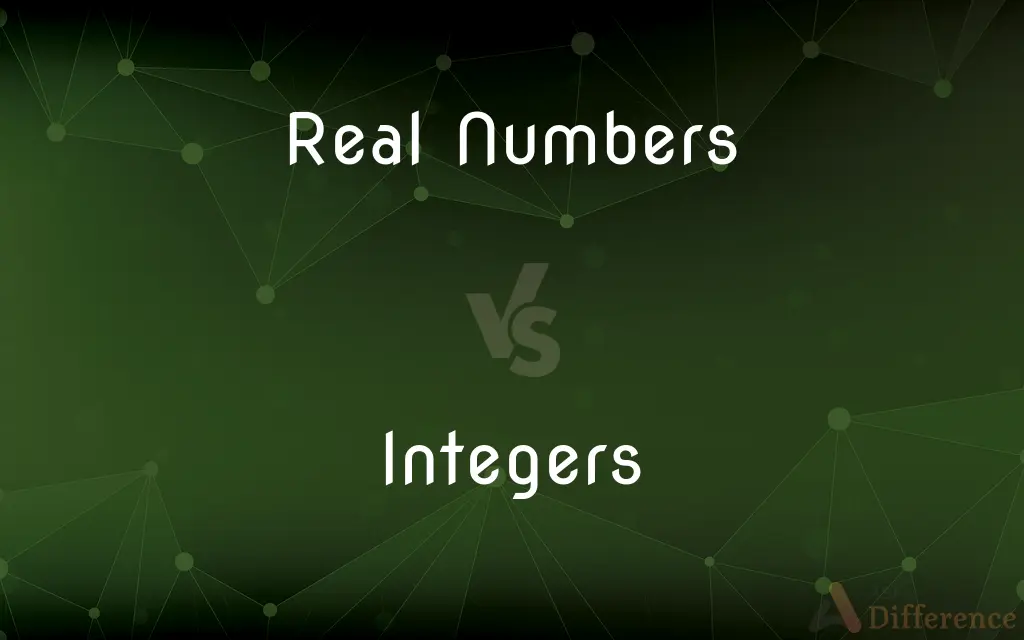Real Numbers vs. Integers — What's the Difference?
By Tayyaba Rehman — Published on October 14, 2023
Real Numbers encompass all rational and irrational numbers, while Integers are whole numbers, including zero, and their negative counterparts.

Difference Between Real Numbers and Integers
Table of Contents
ADVERTISEMENT
Key Differences
Real Numbers constitute a vast set of numbers which incorporate both rational and irrational numbers, effectively including every number that can be positioned on the number line. In stark contrast, Integers form a subset within the real numbers, embracing only the whole numbers, their negative equivalents, and zero, establishing a clear boundary between the amplitude of values that the terms real numbers and integers can denote. Real Numbers, therefore, embody an expansive category, while integers signify a more specific and limited group within them.
Real Numbers can represent quantities like distance, height, or any measurement with utmost precision, allowing for decimal and fractional values to present more exact numbers. Whereas integers, although highly useful in numerous mathematical and practical scenarios like counting, ordering, and more, lack the ability to capture the nuances of values that lie between two consecutive whole numbers. Real numbers facilitate a highly accurate representation of values, whereas integers provide a framework for categorical and absolute number representation.
In the realm of mathematics, real numbers are crucial for advanced calculations and measurements, especially when intricate values or continuous data are being considered. Integers, while indispensable in many mathematical and everyday scenarios, are largely applied in situations that require counting, ordering, or designation. The vital distinction thus lies not just in their scope but also in their applicable domains, where real numbers and integers are utilized for different aspects of measurement and calculation.
Real Numbers are pivotal in providing a rich platform that can aptly represent various values, accommodating the exactness often required in scientific and mathematical endeavors. Contrarily, integers provide a structured and straightforward numerical framework that simplifies calculations and understandings, especially when fractional values are not pertinent or applicable, once again emphasizing the broader applicability of real numbers and the specific, categorical utility of integers.
Comparison Chart
Letters
11
8
ADVERTISEMENT
Vowels
4
3
Consonants
7
5
Syllables
3
2
Word Type
Noun (Plural)
Noun (Plural)
Compare with Definitions
Real Numbers
All rational and irrational numbers.
Real Numbers include fractions like ½ and irrational numbers like √2.
Integers
Whole numbers, their negatives, and zero.
Integers include numbers like -1, 0, and 4.
Real Numbers
Can be expressed with or without decimal points.
Both 3 and 3.14 are considered real numbers due to their numeric representations.
Integers
Can be positive, negative, or zero.
Integers encompass all positive and negative whole numbers and zero.
Real Numbers
Include exact quantities and approximations.
Real numbers can accurately or approximately represent various values.
Integers
Counting numbers without fractional parts.
The number of students in a class is represented by integers.
Real Numbers
Values that can be located on the number line.
The number π is a real number because it has a position on the number line.
Integers
No decimal places are involved.
Integers such as 5 and -5 do not possess decimal components.
Real Numbers
Comprising both positive and negative infinity.
Real numbers can extend toward both positive and negative infinity.
Integers
Can be even or odd numbers.
Both 2 and 3 are integers, but 2 is even while 3 is odd.
Integers
A member of the set of positive whole numbers {1, 2, 3, ... }, negative whole numbers {-1, -2, -3, ... }, and zero {0}.
Integers
A complete unit or entity.
Integers
(mathematics) integer
Integers
(mathematics) The set of all integers; the set {... -3, -2, -1, 0, 1, 2, 3 ...}.
Common Curiosities
Can Integers be negative?
Yes, integers can be negative, positive, or zero.
What are Real Numbers?
Real Numbers include all rational and irrational numbers, both decimals and whole numbers.
Is zero considered an integer?
Yes, zero is considered an integer.
Are all Real Numbers countable?
No, the set of all Real Numbers is uncountable.
Can Real Numbers represent physical quantities?
Yes, Real Numbers can represent physical quantities accurately or approximately.
Are Integers Real Numbers?
Yes, integers are a subset of Real Numbers.
What is the symbol for the set of Integers?
The symbol for the set of Integers is "Z."
Are all Real Numbers rational?
No, Real Numbers can be both rational and irrational.
Are fractions considered integers?
No, fractions are not considered integers.
Do Real Numbers include decimal numbers?
Yes, Real Numbers include decimal numbers.
Can Real Numbers be used in calculus?
Yes, Real Numbers are extensively used in calculus.
Can integers be utilized to count objects?
Yes, integers are widely used for counting.
Do Real Numbers have an algebraic structure?
Yes, Real Numbers have a rich algebraic structure, with operations like addition and multiplication defined.
Is subtraction possible with integers?
Yes, subtraction is possible with integers and yields another integer.
Can Real Numbers represent temperature?
Yes, Real Numbers can accurately represent temperatures, including decimals.
Share Your Discovery

Previous Comparison
In To vs. Into
Next Comparison
Segmentation vs. TargetingAuthor Spotlight
Written by
Tayyaba RehmanTayyaba Rehman is a distinguished writer, currently serving as a primary contributor to askdifference.com. As a researcher in semantics and etymology, Tayyaba's passion for the complexity of languages and their distinctions has found a perfect home on the platform. Tayyaba delves into the intricacies of language, distinguishing between commonly confused words and phrases, thereby providing clarity for readers worldwide.
















































